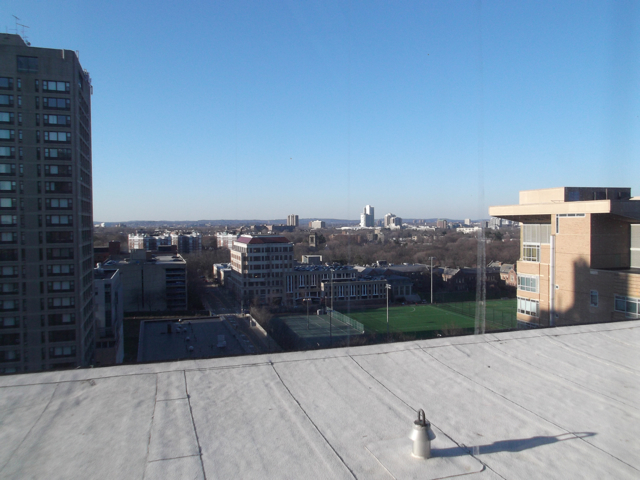2022
Dec
We have had an exciting year with many accomplishments to celebrate! We welcomed two new postdocs: Sivan Gelb and Alexandra Hochstetler and one new graduate student Jill Jones! We also enjoyed hosting summer students Arianna Bethea from Bunker Hill Community College (Kirby program) and Elizabeth Yimer from Virginia Commonwealth University (SHURP program). We were delighted that Arianna decided to stay on in the lab during the school year! This fall, we also enjoyed hosting Maryam Dadabhoy for a rotation from PiN.
We are long overdue to congratulate lab members on papers, grants, and new positions! Check out Ahram’s recent paper harnessing the choroid plexus and CSF to treat toxicity of cancer chemotherapy (Jang et al., Neuron 2022)! We were lucky to collaborate with Naama Kanarek and Bory Petrova, just down the hall, for metabolomics analyses of the CSF. In this study, we found that AAV-based overexpression of the antioxidant SOD3 protected mice from toxicity of cancer chemotherapy. A huge thank you to Rajiv Ratan for writing a Preview of our work (Ratan, Neuron 2022).
Ahram also published a review article summarizing the various approaches for targeting the choroid plexus and CSF for gene expression studies (Jang & Lehtinen, Fluids and Barriers of the CNS 2022). A more detailed protocol of Ahram’s specific technique is forthcoming.
We joined Norman Saunders and Shane Liddelow to contribute a review on the choroid plexus and CSF to the centenary issue of Physiological Reviews (Saunders et al., 2022). Miri also wrote up a News & Views to highlight recent work from the Wyss-Coray lab on protective roles of CSF for aging (Zawadzki & Lehtinen, Nature 2022).
We congratulate Neil Dani and Ryann Fame on starting their own labs – Neil at Vanderbilt and Ryann and Stanford! We bade farewell to Fred, who moved on to data science after completing his PhD, and to Milo, who transitioned to the NIH-IRTA postbac program following graduation from Harvard. Ahram has transitioned to collaborator Mark Andermann’s lab for another postdoc that focuses on imaging-based studies.
We are grateful for private foundation and NIH support of our research. For our trainees, we thank the American Heart Association (Miri’s pre-doc fellowship), Bright Focus Foundation (Huixin’s postdoc grant), NIH T32 Kirby program (Dario’s and Alexandra’s postdoc fellowships), and the Lefler Fellowship and Hebrew University fellowship (Sivan). New and continued research support for the lab includes the Pediatric Hydrocephalus Foundation, Cure Alzheimer’s Fund, Pappendick Family Therapeutic Acceleration Award, Hydrocephalus Association Innovator Award, and the NIH.
Jan
Dario Figueroa Velez joins the lab as our newest postdoc, and Jill Jones begins her rotation in the lab – welcome Jill and Dario! We also enjoyed hosting Olumide Fagboyegun from the PiN program in the fall.
We congratulate Miriam Zawadzki on receiving a pre-doctoral fellowship from the American Heart Association and a research grant from the Little Giraffe Foundation. The lab is grateful for continued support from the Pediatric Hydrocephalus Foundation and a new research grant from the Cure Alzheimer's Fund!
Check our Ryann's review on metabolism in the developing forebrain, available online in Frontiers in Cell and Dev Biology. [Article PDF]
2021
Fall
Tiara Lacey joins the lab for her PhD – welcome Tiara! We also hosted Muhammad Ahmad from the BBS program for a rotation in the lab and congratulate Peter Kalugin on receiving an NIH F30 NRSA to support his training in the MD/PhD program.
Check our Jin and Huixin’s review on choroid plexus immune cells, available online in TINS: [Article PDF]
June
This is the season for lab turnover! We bid farewell to Jin, who transitioned to an industry position, and to Andrea, Mya, and Suhasini who are continuing on to medical schools across the country. Congratulations!
We welcome Aja Pragana (Salve Regina Univ.), Bradford Grant (Davidson College), and Paul Soden (Cornell University) to take the research assistant reins in lab. We are delighted to host Tiara Lacey from the BBS program for a rotation and to welcome Jonathan Harpe (North Carolina Central Univ.) for a virtual internship through Harvard’s SHURP program. Anna Dong joins the lab from Harvard University, and we congratulate Anna and Michaela for receiving research support through Harvard’s HCRP program!
Check out our two recent papers that resulted from wonderful collaborations: Dani & Herbst et al., Cell 2021 and Kaiser et al., Development 2021. In Dani et al., we collaborated with Aviv Regev at the Broad Institute, Naomi Habib and Rebecca Herbst to generate a choroid plexus cellular atlas by single cell sequencing. In Kaiser et al., we collaborated with Karol Kaiser and Vita Bryja from Masaryk Univ. to investigate Meis-Wnt5a signaling and regulation of choroid plexus development.
Dani & Herbst et al., was highlighted recently by the Harvard Brain Initiative:
https://brain.harvard.edu/hbi_news/a-brain-barrier-defined/
and Boston Children’s Hospital:
https://answers.childrenshospital.org/choroid-plexus-atlas/
We also congratulate Neil Dani on receiving a research grant from the BCH Office of Faculty Development.
January
We start the new year full of hope for a healthier, happier year. On the science front, come join us and exchange scientific ideas at the upcoming Cold Spring Harbor Laboratories meeting on Brain Barriers! The meeting will take place virtually in April 2021 and is co-organized by Maria, Dritan Agalliu, and Benoit Vanhollebeke.
We are also pleased to share Huixin and Ryann’s latest research (Xu & Fame et al., Nature Communications 2021), examining CSF secretion and choroid plexus metabolism during early stages of brain development. Recent progress in field has advanced our knowledge of how CSF is secreted by the choroid plexus. However, most research on this topic is based on adult models of brain function, and exactly how CSF is cleared during brain development, before the maturation of CSF outflow pathways of the adult brain, has remained a mystery. In this study, we found that CSF K+, accompanied by water, is removed by the choroid plexus during mouse early postnatal development. At this developmental stage, the choroid plexus showed increased ATP production and increased expression of ATP-dependent K+ transporters, particularly the Na+, K+, Cl-, and water cotransporter NKCC1. Overexpression of NKCC1 in the choroid plexus resulted in increased CSF K+ clearance, increased cerebral compliance, and reduced circulating CSF in the brain without changes in intracranial pressure in mice. Enhancing NKCC1 expression in an obstructive hydrocephalus mouse model also mitigated ventriculomegaly. Collectively, our results implicate NKCC1 in regulating CSF K+ clearance through the choroid plexus in the critical period during postnatal neurodevelopment in mice. Check out the paper for more details at: [Article PDF]
This new year, we are grateful for support from the Harvard Brain Science Initiative ALS Seed Grant program, supported by the Stephen Van R. Winthrop Fund for ALS Research, which is helping us launch a new line of investigation into Amyotrophic lateral sclerosis.
2020
Dec
Due to the Covid pandemic, the lab scaled down our bench research program in March 2020 and transitioned to remote research activities for most of the spring. As we cautiously resumed bench work in the summer, virtual meetings and seminars became the new normal, along with a focus on data analysis, reading, and writing. The pandemic has touched us in many ways, requiring our patience, compassion, support, adaptability, creativity, perseverance, and resilience.
As we returned to lab in June, we were delighted to welcome Ya’el Courtney for her PhD! We also welcomed undergraduate students Aja Claire from Harvard’s SHURP program, Andrea Yessaillian from Northeastern University for her senior thesis, and Elizabeth Xu, our Winsor graduate, now at Penn!
In early June, we celebrated Dr. Fred Shipley’s PhD defense, who decided to stay on as a postdoc, continuing his studies on the secret life of the choroid plexus. We also celebrated Peter and Miriam’s successful qualifying exams.
We published several papers this year, including our collaborative efforts to develop imaging technologies for the choroid plexus. We are grateful to all of our collaborators for their efforts and enthusiasm to join our mission to rein in the choroid plexus.The first study, led by Fred and Neil (Shipley & Dani et al., Neuron 2020), presents two platforms for investigating choroid plexus function in adult mice on a cellular level. In the first platform, we microdissected the choroid plexus from the lateral ventricle and stabilized it either for immunostaining or for live imaging of epithelial cells. In the second platform, we implanted an imaging window – a “skylight” – into adult mice, that allows imaging choroid plexus cells in their natural state. The in vivo approach has allowed us to track epithelial cell activity and secretion, as well as immune cell movements and behaviors in response to acute local and peripheral challenges.
In the second study led by Jin (Cui et al., Developmental Cell 2020), we focused on the embryonic brain, where immune system disturbances resulting from maternal inflammation during pregnancy are known to increase the susceptibility of offspring to neurodevelopmental disorders.
We used a maternal immune activation (MIA) model to mimic viral infection in pregnant mice, and tested whether the embryonic choroid plexus participates in inflammatory responses in the fetal brain. Remarkably, MIA triggered the accumulation of phagocytic macrophages at the embryonic choroid plexus and a pro-inflammatory CSF signature. Among the upregulated cytokines, the chemoattractant CCL2 was the most robustly increased in both the CSF and choroid plexus. To better understand this process, we adapted the imaging toolkit from Shipley, Dani et al., to track embryonic choroid plexus macrophage behaviors in real time. We also found, using histological approaches, that augmenting CSF-CCL2 was sufficient to disrupt the choroid plexus epithelial cell barrier and drive choroid plexus immune cell recruitment, proliferation, and activation. This coordinated response culminated in choroid plexus macrophages relocating to the choroid plexus free margin, where they breached the weakened epithelial barrier. Further analyses demonstrated that these immune cells enter the ventricles via anatomically specialized “hotspots” at the distal tips of choroid plexus villi. In newborn mice, choroid plexus-driven inflammation drives brain malformations reminiscent of MIA phenotypes reported by others. Thus, the developing choroid plexus both mounts an inflammatory response and provides a gateway for immune cell entry into the brain.
We thank Britta Engelhardt for her Preview on our work, published in Developmental Cell.
Collectively, our two papers were highlighted recently by the Harvard Brain Initiative:
https://brain.harvard.edu/hbi_news/the-secret-life-of-the-choroid-plexus/
and Boston Children’s Hospital:
https://discoveries.childrenshospital.org/choroid-plexus-inflammation/
We are inspired by progress made by colleagues in the field including the laboratory of John Gilmore on studies involving CSF accumulation and the early diagnosis of autism and other neurodevelopmental disorders, highlighted in Xu & Lehtinen, Biological Psychiatry: CNNI 2020, as well as advances made by the laboratory of Madeline Lancaster in culturing and applications for choroid plexus organoids, highlighted in Xu & Lehtinen, Cell Stem Cell 2020.
We congratulate Ryann Fame on receiving a grant from the BCH Office of Faculty Development to support her research for the next 2 years. We are also grateful for the continued support of our lab’s research during this time and specifically thank the Pediatric Hydrocephalus Foundation, the Shanley Family, Harvard Brain Science Initiative Bipolar Disorder Seed Grant program, and the NIH.
Summer
We welcome Ya’el Courtney from PiN to rotate in the lab! We are also delighted that Peter has joined our lab and Mark Andermann’s lab for a joint PhD!
Learn more about the CSF by checking out Ryann’s review article, “Emergence and Developmental Roles of the Cerebrospinal Fluid System,” published in the February issue of Developmental Cell. [Article PDF]
Come join us at the upcoming Keystone Symposia, “Cerebral Fluid Flow and Function: Lymphatics, Glymphatics, and the Choroid Plexus,” taking place in Santa Fe and co-organized by Maria, Ed Monuki, and Maiken Nedergaard.
We are grateful for continued support from the Pediatric Hydrocephalus Foundation to support our research on the underlying causes of hydrocephalus.
2019
Fall
Miriam joins the lab for her PhD! We also welcome Lyuba Bolkhovitinov from BBS and Peter Kalugin from PiN to rotate in the lab. Congrats to Ryann on her promotion to Instructor as well as her annual swim to support hydrocephalus research in the Boston Sharkfest!
On a related note, learn about some of our on-going collaborative work including a project relating to acquired hydrocephalus resulting from intraventricular hemorrhage in the brain: Read more...
Check out our two new papers:
Fame et al., (in Development)
Lun, Shannon et al., (in American Journal of Pathology)(selected for the cover!)
Fame et al., builds on our lab’s proteomic analyses of the earliest brain fluids, the amniotic and cerebrospinal fluids, which contain surprisingly high levels mitochondrial, ribosomal, and translation-related proteins, whose expression patterns decrease in CSF as development progresses. While our prior studies examined ribosome biogenesis and translation at these stages (Chau et al., eLife 2018), in this new study, we uncovered parallel, coordinated transcriptional changes in metabolic machinery in forebrain progenitors during this early stage of forebrain specification. Progenitors showed striking mitochondrial structural changes transitioning from glycolytic cristae at E8.5, to more traditional mitochondria at E10.5. Accordingly, glucose usage shifted in progenitors such that E8.5 progenitors relied on glycolysis, and after neural tube closure, increasingly used oxidative phosphorylation. This metabolic shift was again matched by changes in surrounding amniotic and cerebrospinal fluid proteomes. Importantly, these mitochondrial morphological shifts depend on c-MYC downregulation, as shown by mouse genetics approaches. Collectively, these findings demonstrate metabolic shifting accompanies dynamic organelle and proteostatic remodeling of progenitor cells during the earliest stages of forebrain development. As missteps in protein biosynthesis are implicated in a growing number of neurodevelopmental disorders, these data reveal an entirely new set of targets for better understanding the complex process of early brain development and underscore the utility of CSF proteomics in this process.
Lun, Shannon, et al., takes a closer look at DNA repair mechanisms in the developing cerebral cortex in the context of Ligase4 syndrome, a devastating immunodeficiency in which impact on brain development remains poorly understood. We first characterize the brain phenotype in the Lig4R278H/R278H (Lig4R/R) mouse model of DNA Ligase 4 (LIG4) syndrome, in which a hypomorphic Lig4 mutation, originally identified in patients, impedes DNA repair. We found that Lig4R/R mice develop microcephaly, resulting primarily from apoptotic death of newborn neurons that is both spatially and temporally restricted during cortical development. This apoptosis leads to a reduction in neurons throughout the postnatal cerebral cortex, but with a more prominent impact on those of the lower cortical layers. Our findings contribute to a better understanding of the pathogenesis of microcephaly in LIG4 syndrome and open avenues to more focused investigations on the critical roles of DSB formation and repair in vulnerable neuronal populations of the brain.
August
A warm welcome to Miriam Zawadzki (BBS and MD/PhD programs), who will join us for a fall rotation, and Michaela Benedict (Harvard University), who will join our imaging team for an undergraduate research project!
The lab was awarded a BRAIN Initiative grant from the NIH to develop imaging techniques for the choroid plexus and CSF! This is an exciting, collaborative enterprise with Mark Andermann (BIDMC/HMS) and Chris Moore (Brown University).
We congratulate Ryann and our collaborators Lauren Orefice and David Ginty at HMS on their new discoveries involving potential therapies for tactile-related phenotypes in autism spectrum disorder, published this week in Cell.
July
Maria co-organized with colleague Fiona Doetsch (Univ. Basel) a Company of Biologists Workshop on the choroid plexus and CSF in West Sussex, England. What a terrific opportunity to meet with the international community to learn and discuss the latest developments on this exciting frontier!
June
We are delighted to welcome Mya Webb from Davidson College, and Suhasini Gupta from UCLA as our new research assistants! We also have a number of summer students with us including Miguel Marin-Rodero for a rotation from the Immunology program, Chris Naranjo, our SHURP student from the Univ. of Miami, and Elizabeth Xu from the Winsor School. We bid farewell to Morgan (heading for medical school at Vanderbilt) and Josh (heading for a Neurobiology PhD at Stanford). Best of luck with your future adventures in science and medicine!
May
Check out our single cell atlas of the choroid plexus across brain ventricles and ages! Congrats to Neil, Rebecca, Naomi, and our fantastic collaborators in the Regev lab at the Broad Institute. Our preprint is available on BioRxiv.
We are delighted to welcome Sayo Falayi from Emmanuel College to carry out her thesis research in the lab. We congratulate Kolby Shaw from Simmons College on a productive senior thesis project and wish her best of luck on all new adventures after graduation!
April
Check out Ryann’s Spotlight article in this issue of Neuron highlighting work from the labs of Nathalie Spassky and Arturo Alvarez-Buylla on the development of ependymal cells and adult neural stem cells in the SVZ.
March
Congratulations to Jin for receiving the William Randolph Hearst Fellowship to support her project on the choroid plexus brain barrier during prenatal development. The lab was also awarded a Pilot Grant from the Simons Foundation to advance studies on choroid plexus-CSF contributions to autism spectrum disorder.
The lab is honored to also receive a Harvard Brain Initiative Seed Great to investigate mechanisms of Bipolar Disorder. This grant is made possible by a generous gift from the Dauten Family Foundation. We are grateful for this support and look forward to a productive year!
January
We kick off the New Year congratulating Neil on the Reagan Sloane Shanley Scholarship! The lab was selected to receive continued support from the Pediatric Hydrocephalus Foundation.
2018
December
We wrap up the year by thanking our energetic rotation students Genevieve, Jessica, and Valentina, for a fantastic Fall semester! Maria was also honored by a 2018 Mentoring Award from the Boston Children’s Hospital Postdoc Association.
September
Congratulations to Ryann for “taking a bite out of hydrocephalus,“ with her mile-long swim across the Boston Harbor, an annual tradition for raising awareness and resources for hydrocephalus research! We also welcome Kolby Shaw from Simmons College to carry out her Senior Thesis Research.
August
Check out our new publication, available online in Neuron (Smith et al., 2018), where we found that the gene SCN3A, which encodes the sodium channel Nav1.3, regulates folding of the human brain and oral motor development. Patients with mutations in SCN3A develop a neurodevelopmental channelopathy that includes a highly regionalized brain malformation/polymicrogyria in the Perisylvian region of the brain. This part of the brain is home to our speech and language areas, and patients with SCN3A mutations present with developmental language delay and oral motor difficulties. To date, genetic evidence connecting cortical malformations with oral motor and developmental language disorders is limited, and we anticipate this work should open doors to better understanding these complex developmental processes and associated conditions. [Article PDF]
Read more at:
Preview in Neuron
New York Stem Cell Foundation
The lab was selected to receive the Hydrocephalus Association’s 2018 Science Discovery Grant to investigate mechanisms of post-hemorrhagic hydrocephalus. We are eager to get started - congratulations to the entire team!
We’ve also enjoyed a productive summer with our SHURP summer interns Joel and Della, and also bid farewell to Bella from the Pediatric Hydrocephalus Foundation, who conducted an internship in the lab.
July
We welcome Cameron Sadegh from MGH for his neurosurgery fellowship training in the lab for the next 2 years!
Check out our recent collaborative publication (Coulter et al., Cell Reports 2018) describing a new mechanism regulating Shh secretion in distinctive extracellular vesicles by the choroid plexus.
June
Congratulations to Melody on graduating from the MD/PhD program and matching at UCSF for residency training in Pediatrics/Neonatal medicine beginning in June! We also bid farewell to Kevin, who is headed to the opposite edge of the Pacific rim for postdoctoral training with Ayumu Toshiro (NTU, Singapore). Best of luck Melody and Kevin!
We are joined by two SHURP students for the summer, Della Syau (UCSD) and Joel Reyes (Univ. Texas at El Paso) – welcome to the lab!
Morgan attended the American Association of Neuropathology Meeting and received an Honorable Mention for the best project in experimental neuropathology – congratulations!
May
Take a look at our newest article published online in eLife (Chau et al.,) where we discovered that neural progenitor cells dynamically regulate protein biosynthetic machinery during early forebrain development. This fundamental process matches concurrent changes in the adjacent cerebrospinal fluid (CSF) proteome, and is regulated in part by the transcription factor c-MYC. We previously showed that the CSF delivers important health- and growth-promoting factors for the developing brain. Our new work expands on this role to demonstrate that the CSF provides a biomarker signature of healthy mammalian forebrain development, analogous to its common role as a source of biomarkers for neurologic disease throughout life.
Congrats to Morgan for being selected for a Trainee Travel Award for the upcoming American Association of Neuropathology Meeting in June!
April
We are celebrating Maria’s promotion to Associate Professor of Pathology at Harvard Medical School!
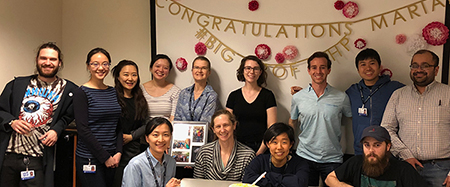
March
We have many achievements to celebrate this spring! Check out our article published in The American Journal of Pathology (Shannon et al.,) where we generated a new mouse model for two rare pediatric cancers: choroid plexus carcinoma and ciliary body medulloepithelioma (eye tumor). We are also celebrating the fantastic news of our newly funded research grant from the Human Frontier Science Program. This exciting multi-lab collaborative project with Claire Wyart (INSERM, Paris) and François Gallaire (EPFL, Lausanne) investigates CSF production and flow.
January
This New Year, we are delighted to welcome Huixin Xu as a postdoctoral fellow, and Hannah Zucker, a rotation student from the Program in Neuroscience. We congratulate Neil on a Glenn/AFAR Postdoctoral Fellowship, and are grateful for continued funding from the Pediatric Hydrocephalus Foundation.
2017
October
We welcome Yidi Wang from the BBS and MD/PhD Programs to rotate in the lab.
August
Maria joined the Pediatric Hydrocephalus Foundation on Capitol Hill for a fruitful day of meetings with Senate and House of Representatives staff. The event followed a productive internship week with Bella.
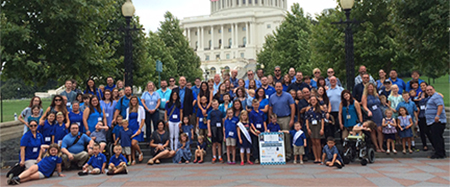
We mixed science and nature on our lab retreat north of the border and celebrated our newly funded grant from the Tommy Fuss Center for Neuropsychiatric Disease Research.
June
We welcome our summer undergraduate interns: Alexandria Velasquez (Harvard SHURP program), and Tyler LeComer (Harvard’s PRISE program), and summer rotation students: Christina Tringides (Biophysics program) and Jenny Lai (MD/PhD program). We bid farewell to Dr. Kevin Chau, who is embarking on his new scientific path at Biogen. We also enjoyed hosting Jackson Broderdorp for an internship from the Providence Day School in Charlotte, NC. Best of luck Kevin and Jackson!
April
Kevin successfully defended his PhD - congratulations Dr. Chau!
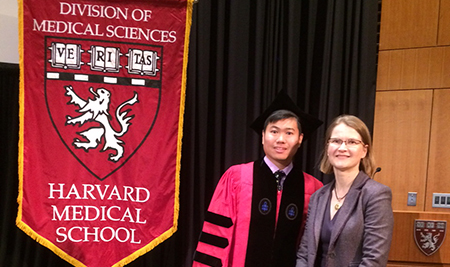
Congratulations Fred for being awarded an NSF Graduate Research Fellowship! This award will support Fred’s dissertation research in the lab during the next three years. We are also thrilled that Tyler LeComer received a PRISE fellowship from Harvard University to carry out summer research in the lab. Finally, check out our recent collaboration with the Lehesjoki Lab (Anttonen et al., Brain 2017), where we characterized the genetic and molecular mechanisms contributing to PEHO syndrome, a severe pediatric encephalopathy.
January
We are celebrating the news that Maria has received the Presidential Early Career Award for Scientists and Engineers (PECASE) from President Obama! Check out the White House press release here.
We are ringing in the New Year by welcoming Jin Cui as a new postdoctoral fellow to the lab! We are also grateful for continued research support from the Pediatric Hydrocephalus Foundation, and are looking forward to a productive 2017!
2016
November
We welcome Ryann Fame as a postdoctoral fellow to the lab! Also check out Neil’s Preview published in Cell Stem Cell (Dani & Lehtinen), “CSF makes waves in the neural stem cell niche.”
October
Maria is selected as Robertson Neuroscience Investigator of the New York Stem Cell Foundation for innovative research in neuroscience. This grant supports the next five-year phase of the lab’s research program investigating the mechanisms regulating the choroid plexus-CSF stem cell niche. http://nyscf.org/programs/nyscf-investigator-program
September
Fred Shipley joins the lab for his PhD from the Biophysics program, and Alec Walker from the Immunology program starts a fall rotation in the lab. Welcome Fred and Alec! It is also time to bid farewell to our summer student Zeynep – good luck with your studies in the coming year! We also had a wonderful time participating in the Pediatric Hydrocephalus Foundation walk in western Massachusetts.
August
Check out our recent publication in Science (Mathew et al.) where we discovered that foot shock, which is commonly used for contextual fear conditioning in learning and memory studies, suppresses gene expression in the choroid plexus. Given its proximity to the hippocampus, the lateral ventricle choroid plexus can be accidentally included in hippocampal dissections. We propose a metric for verifying the purity of hippocampal samples before performing extensive analyses. We are grateful for funding from the Simons Foundation, which supports our research relating to autism spectrum disorder. We are grateful for funding from the Simons Foundation, which supports our research relating to autism spectrum disorder.
April
Congratulations to Dr. Melody Lun for successfully defending her Ph.D.! Melody will now return to medical school to finish her MD.
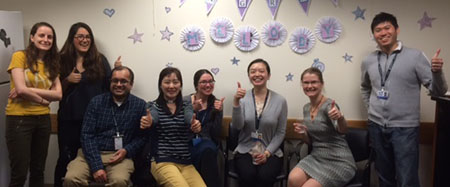
Today we enjoyed a lab lunch to welcome Ahram Jang as a new postdoctoral fellow to the lab – welcome Ahram! We also celebrated Emily Messelaar’s rotation in the lab, and Hillary’s acceptances to medical school. Congrats also to Melody and our collaborators in Haotian Zhao’s lab at Sanford Research for our recent publication (Li et al.) describing a new connection between cilia and choroid plexus tumors published in Nature Cell Biology. The lab also received a grant from the Harvard Stem Cell Institute. Congratulations to all!
Jan
We are celebrating an exciting start to the new year! We welcome Fred Shipley from the Biophysics Program to rotate in the lab. Neil was awarded a postdoctoral fellowship from the William Randolph Hearst Fund, and Kevin received an SFN travel award to the Japan Neuroscience Society meeting in 2016. The lab also received recent grants from the Broad Institute, Boston Children’s Hospital, and continued research support from the Pediatric Hydrocephalus Foundation. Congratulations to all!
2015
Dec
Check out our new paper, published today in Developmental Cell (Chau et al.). In this collaborative effort with Hanno Steen and Anthony LaMantia’s labs, we developed new techniques to collect and analyze the function and composition of early amniotic fluid and CSF as they diverge in the developing nervous system. Congratulations to Kevin and everyone who contributed to this study. Read more at:
HMS Prenatal Proteomics:
How amniotic and cerebrospinal fluids talk to the developing brain: proteomics
4th Annual Lehtinen/Andermann Labs Holiday Party, ping pong tournament, and Yankee Swap. Who went home with the brain cookie jar?
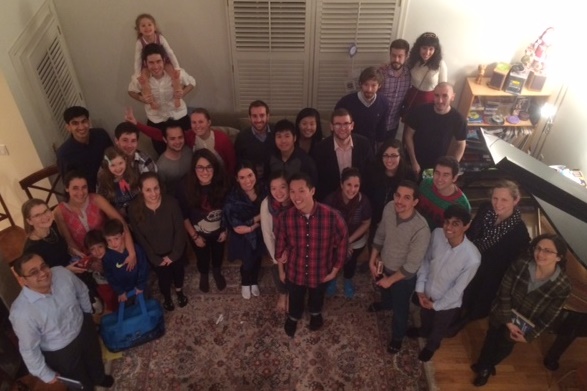
October
Kevin and Melody presented posters at the Society for Neuroscience in Chicago, and we celebrated Melody’s SFN Trainee Professional Developmental Award. The lab’s research was also recognized and honored by a Cajal Club Cortical Explorer Award to Maria.
July
Check out our review describing the development and functions of the choroid plexus-CSF system (Lun et al.), published today in Nature Reviews Neuroscience.
May
Congratulations to collaborators Jessica Chang and Hazel Sive from the Whitehead Institute and MIT for their paper demonstrating zebrafish CSF promotes survival of the developing nervous system in a retinoid-dependent manner, published online today in Developmental Neurobiology. In this paper, we also compare the proteomes of rodent and zebrafish CSF and show that mouse CSF can substitute for zebrafish CSF to promote survival.
Erin Fonseca, Northeastern co-op student joins the lab – Welcome Erin!
March
Check out our paper published today in The Journal of Neuroscience (Lun et al., 2015) where we show regionalization of the choroid plexus tissues in the brain and ventricle-specific CSF production. This has been a collaborative effort with many labs, including our neighbors and friends in the department Hanno Steen and Hart Lidov, Nenad Sestan at Yale, Michael Holtzman at Washington Univ., and Ed Monuki at UC-Irvine. Congratulations Melody and everyone involved!
Feb
Good-bye lunch for Tais, sampling some of her favorite Brazilian specialties at Muqueca in Cambridge. We will miss you!
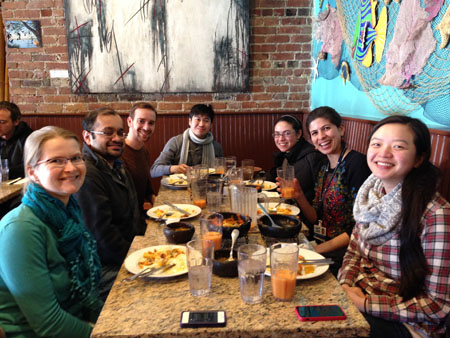
2014
Dec
3rd annual Andermann/Lehtinen holiday party and yankee swap – Happy Holidays!
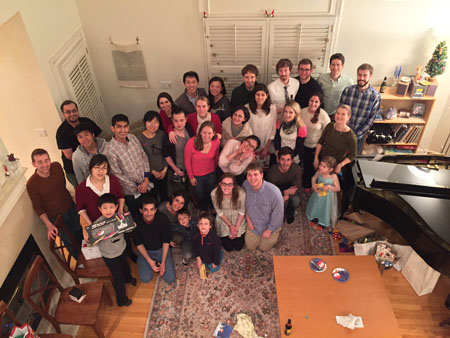
Neil Dani joins the lab as a postdoctoral fellow. Neil recently completed his PhD at Vanderbilt University working on Drosophila synapses and extracellular matrix proteins in the Broadie lab – Welcome Neil!
Lab retreat north of the border to Quebec, Canada. What a view from the Owl’s head summit!
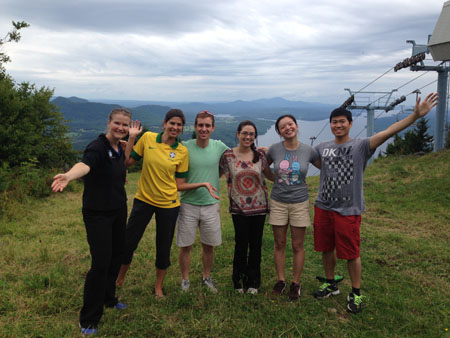
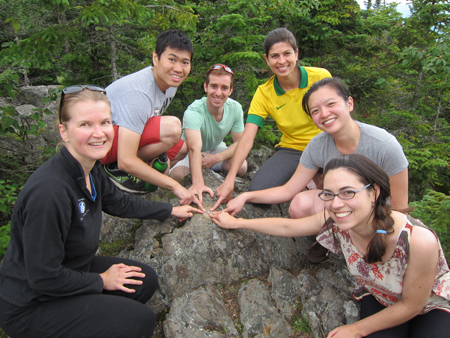
June
Lab hiking trip to the Blue Hills and farewell party for Hye-yeon and Mark. Hye-yeon is moving to Novartis and Mark is starting his PhD at Harvard in the BBS program.
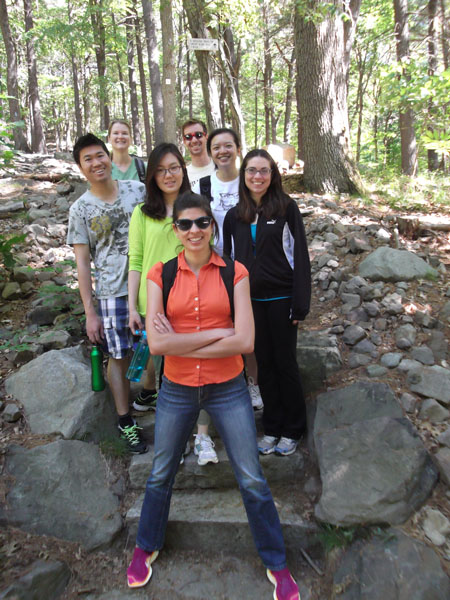
Hillary Mullan joins the lab as our new research assistant. Hillary just graduated from the Oberlin College Neuroscience program – Welcome Hillary!
May
The lab is awarded an R01 grant from the NIH – National Institute of Neurological Disorders and Stroke (NINDS). This 5 year grant will support the lab’s efforts to investigate how the CSF system first forms in the developing brain, and how protein signals in the early CSF influence neural stem cells and the earliest stages of brain development. The lab has also been supported by a K99/R00 from the NINDS over the past several years. We are grateful for this support.
April
Mark receives an NSF graduate research fellowship – Congratulations Mark!
Feb
Tais Adelita joins the lab from Sao Paulo, Brazil, for her 1-year research fellowship supported by the Sao Paulo Research Foundation – Welcome Tais!
2013
Dec
2nd annual Andermann/Lehtinen holiday party – Happy Holidays!
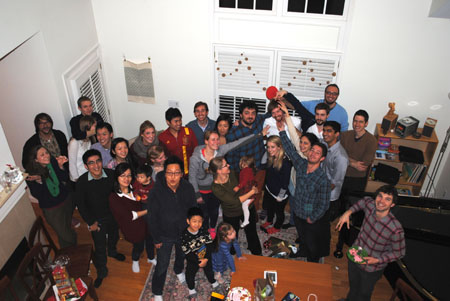
Nov
Maria is honored at the Society for Neuroscience meeting with a Janett Rosenberg Trubatch Career Development Award!
April
Melody receives a Glenn/AFAR Scholarship for her project on the adult choroid plexus – Congratulations Melody!
Welcome Hye-yeon Park from the Program in Neuroscience at Harvard, and good-bye Alex and Vivian! Vivian is graduating from Northeastern, and Alex will pursue an MA at Boston University. We will miss you - good luck!
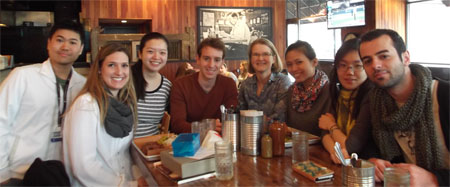
March
Kevin receives an NSF graduate research fellowship, which will support the next 3 years of his dissertation research – Congratulations Kevin!
Check out our JoVE protocol (Zappaterra et al.) published today on culturing cortical explants with CSF.
2012
Dec
Great news - the lab is awarded a Research Grant from the Pediatric Hydrocephalus Foundation! This grant will support our research to investigate mechanisms leading to hydrocephalus and the consequences of hydrocephalus on brain development.
1st annual Andermann/Lehtinen holiday party and yankee swap – Happy Holidays!
Sept
Kevin Chau joins the lab for his PhD from the BBS Program at Harvard – Welcome Kevin!
Aug
Salih Topal joins the lab for his MA from the Univ. of Strasbourg, France – Welcome Salih!
Melody Lun joins the lab for her PhD. Melody is in the MD/PhD program at Boston University – Welcome Melody!
July
Mark Springel joins the lab as our new research assistant. Mark just graduated from Williams College – Welcome Mark!
June
Alexandra Stough joins the lab for a summer internship from Bucknell University – Welcome Alexandra!
Feb
Maria is honored by an Alfred P. Sloan Foundation Fellowship!
Jan
Vivian Ho joins the lab as an undergraduate co-op student from Northeastern University – Welcome Vivian!
Check out our lab space and views of Boston from the 11th floor of the Enders Research Building - Maria and Alex are hard at work setting up the new lab! Come get a tour – we are excited to show everyone around.
Lab Set Up
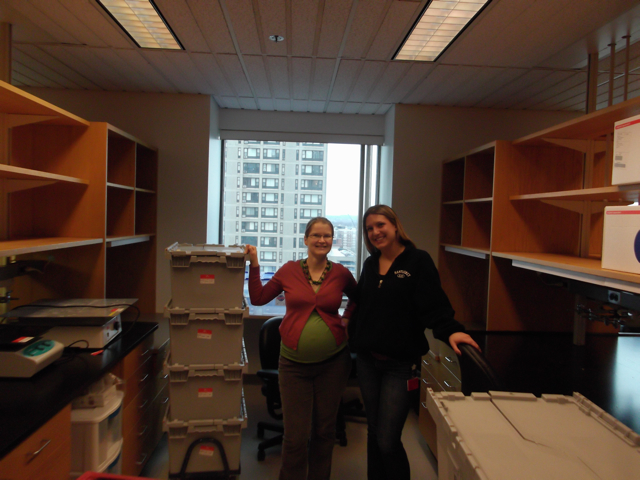
Lab Space
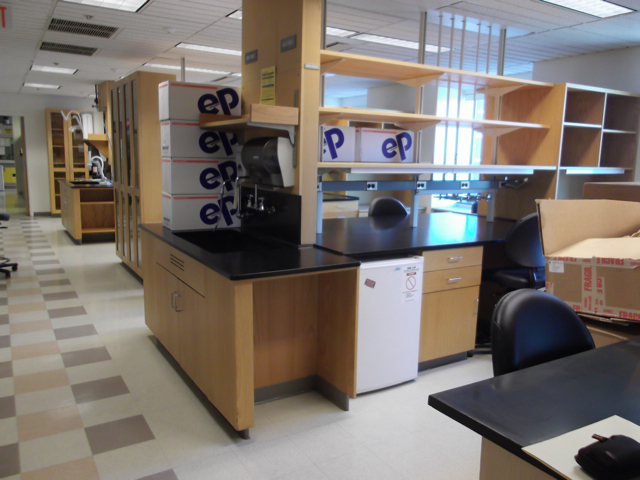
Lab View
